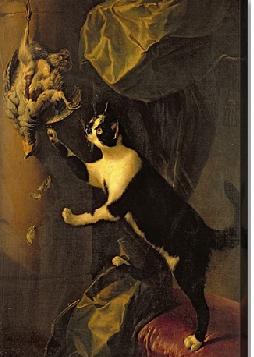... Desportes continued his artistic training at the Académie Royale where he was able to learn about traditional classical drawing but was also able to continue with his favoured painting method – en plein air. Desportes had to fund his schooling, as well as buy food and pay for his lodgings, and to do this he earned money by designing stage scenery, gained portrait commissions and commissions to paint decorations in Paris hotels...
During the 1680’s he assisted the French painter Claude Auran III in supplying paintings for Louis Joseph de Bourbon, Duc de Vendôme’s Chateau d’Anet.....
Desportes ... despite his financial hardship, Alexandre-François Desportes married Eléonore-Angélique Baudet. His wife was a linen and lace maker and through her occupation she was able to support her husband and allow him to search out commissions and carry on with his studies...
Desportes['] luck changed when in 1695 he received an invitation from the French ambassador to Poland to come to the court of the Polish king John III Sobieski who was also the Grand Duke of Lithuania. Desportes was commissioned to paint portraits of the king, his wife Maria Kasimiera and some of the palace courtiers. His stay at the royal court lasted less than a year as the Polish king died in June 1696. Desportes was summoned to return to France by Louis XIV.... [H]e ... decided to revert back to the training he received from Nicasius Bernaerts – the depiction of animals and still life painting and as a twist to this he would incorporate the two in his artistry. In August 1699 Desportes was received into the Académie Royale as an animal painter ...
Louis XIV had started to have his palace at Versailles built in 1664 and he decided to incorporate a menagerie within the palace’s park. The design of his menagerie was in line with other Baroque menageries of the time with its circular layout, in the centre of which was a magnificent pavilion. People were able to walk along the paths which surrounded this central building, and alongside them were the cages which housed the wild animals. The king had been very impressed with the animal paintings of Desportes and commissioned him to complete five works of art which depicted animals and hunting scenes for the menagerie pavilion. Desportes, ... often went on hunting trips with Louis XIV .... During the hunt he would carry with him a small notebook in which he would make on-site sketches of the hunt “trophies” – the dead animals, which could then be used later for still-life depictions of the game that resulted from the day’s hunt, Louis XIV would then choose the best sketches and Desportes would go off and complete an oil on canvas painting of the king’s chosen subject. ....

Louis XIV was so pleased with these paintings that in 1702, he commissioned Desportes to paint six works, portraying the portraits of the hunting dogs which were his personal favourites. In one such work entitled Bonne, Nonne and Ponne [above] we see the king’s three favourite hunting dogs chasing and flushing out pheasants and partridges from the long grass. The king was so pleased with the work Desportes produced for him [again above] that he awarded him a pension and two years later he made Desportes a councillor of the Académie Royale.
Desportes reputation as an artist spread outside of France and soon he was in high demand. In 1712 he visited London and stayed for six months working on commissions. When Louis XIV died in 1715, Desportes carried on working for the Regent of France, Philippe, Duc d’Orleans, who was ruling for the infant Louis XV, the grandson of Louis XIV and over time provided many paintings for the royal residences at Versailles, Marly, Meudon, Compiègne and Choisy. It was not just hunting scenes that Desportes had mastered for he also spent time painting still-life works featuring the dead “trophies” brought back from the hunt cleverly arranged alongside floral displays or displays of vegetables lying on a table or even in landscape settings. ...
Below is an example, titled "Dog with Flowers and Dead Game" by Alexandre-François Desportes (1715).

Below is another work by Desportes, "Still Life with Silver" dated to c.1720.

Our blogger says of the art above:

Below is another work by Desportes, "Still Life with Silver" dated to c.1720.

Our blogger says of the art above:
This is what one might have seen as a centrepiece on the table if we had attended a royal banquet. At the centre we can see the dragon-handled tureen and vermeil salvers both of which are in the Régence style of 1715-23.
And here is a work along these lines but with a feline twist, for the painting below is also by
Alexandre-Francois Desportes.
Alexandre-Francois Desportes.

No comments:
Post a Comment